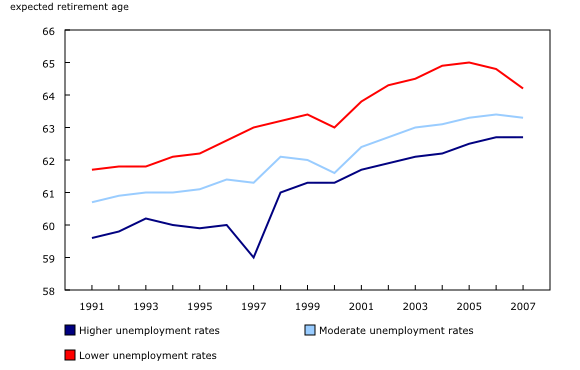Study: The local unemployment rate and retirement, 1991 to 2007
Archived Content
Information identified as archived is provided for reference, research or recordkeeping purposes. It is not subject to the Government of Canada Web Standards and has not been altered or updated since it was archived. Please "contact us" to request a format other than those available.
Released: 2015-04-22
Workers in economic regions that had a higher unemployment rate were expected to retire two years earlier, on average, than workers in economic regions with a lower unemployment rate.
In 2007, for example, workers in the economic regions with higher unemployment rates, 9.7% on average, were expected to retire at 62.7 years of age.
Conversely, workers in economic regions with lower unemployment rates, 3.9% on average, were expected to retire at 64.2 years of age.
Workers in regions with higher rates of unemployment had a lower expected age of retirement in every year between 1991 and 2007.
The relationship between the local unemployment rate and the probability to retire remained when other factors associated with retirement were taken into account. This suggests that local economic conditions play a role in a worker's decision to retire.
Other factors related to the probability of an earlier retirement included the presence of a disability, access to Employment Insurance benefits, unionization and having contributed to a registered pension plan for at least five years.
Single men were more likely to retire earlier than those who were married or divorced. Among women, those who were married were more likely to retire early.
Note to readers
In this study, data from the Longitudinal Administrative Databank (LAD) are used to examine the relationship between the local unemployment rate (measured at the economic region level) and the expected age of retirement.
The economic regions have been divided into three equal-sized groups: those with high unemployment rates, those with low unemployment rates and those falling in between.
Because unemployment rates vary over time, regions were not always classified in the same group every year. Since the LAD does not have information about the labour market activities of individuals, final retirement is identified by examining the employment income patterns of taxfilers over a number of years.
The expected age of retirement is based on a method similar to the one used for life expectancy, and can be obtained by calculating the number of years individuals aged 50 are expected to remain in the labour market.
The article "The local unemployment rate and permanent retirement" is now available online in Insights on Canadian Society (Catalogue number75-006-X). From the Browse by key resource module of our website, choose Publications. A detailed version of the same study, titled "Impact of the local unemployment rate on permanent retirement," is also available online in Labour Statistics: Research Papers (Catalogue number75-004-M).
Contact information
For more information, contact us (toll-free 1-800-263-1136; 514-283-8300; infostats@statcan.gc.ca).
To enquire about the concepts, methods or data quality of this release, contact Diane Galarneau (613-854-3018; diane.galarneau@statcan.gc.ca), Labour Statistics Division.
For more information on Insights on Canadian Society, contact Sébastien LaRochelle-Côté (613-951-0803; sebastien.larochelle-cote@statcan.gc.ca), Labour Statistics Division.
- Date modified:


